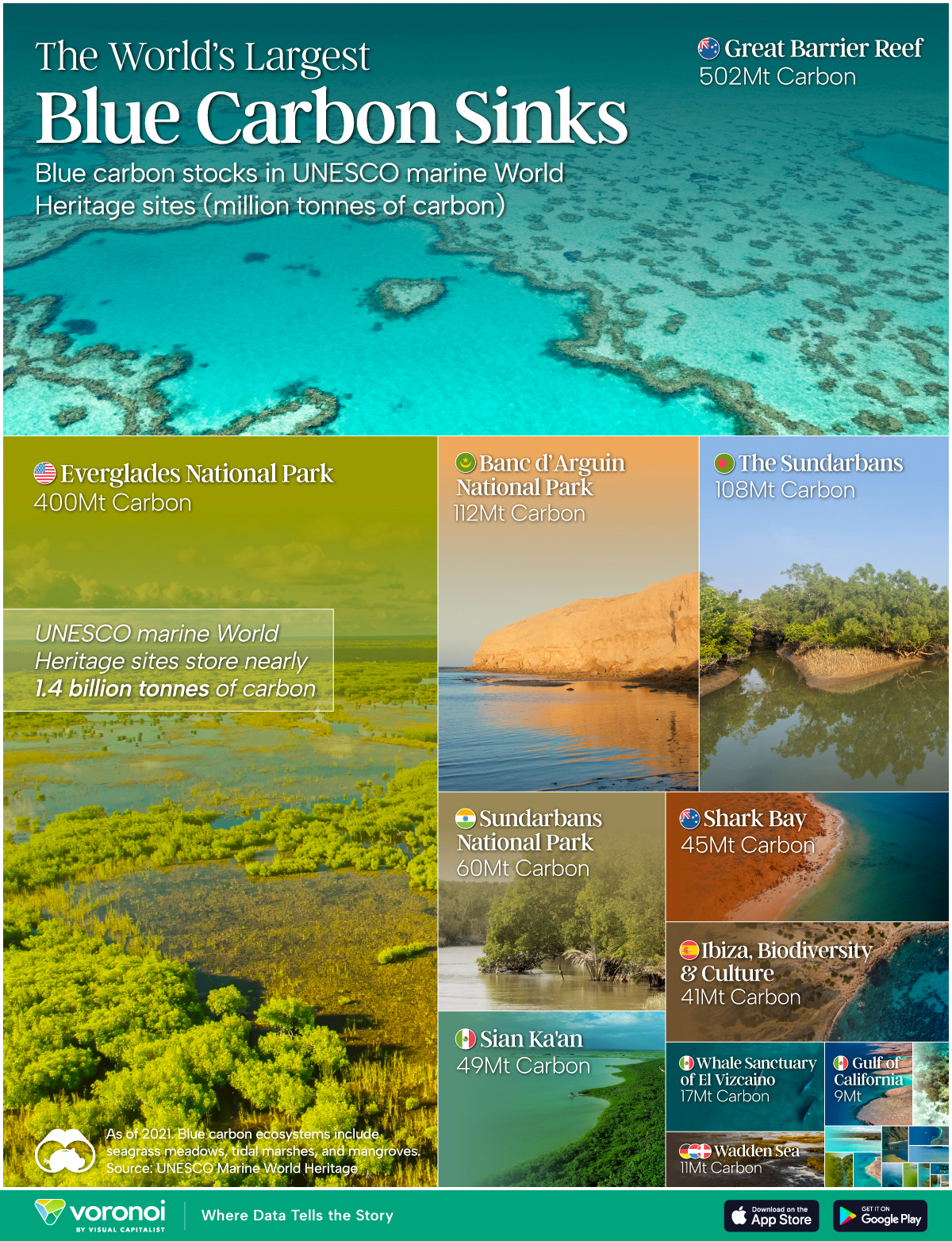The World’s Largest Blue Carbon Sinks
This was originally posted on our Voronoi app. Download the app for free on iOS or Android and discover incredible data-driven charts from a variety of trusted sources.
Key Takeaways
- A UNESCO marine World Heritage site is a coastal or oceanic area recognized by UNESCO for its outstanding universal value to humanity, protected under the World Heritage Convention for its natural and cultural significance.
- Australia’s Great Barrier Reef is the world’s largest coral reef system, playing a critical role in global carbon storage.
The ocean is one of Earth’s most powerful carbon sinks, absorbing carbon dioxide and helping stabilize the climate. Within this system, UNESCO-designated marine World Heritage sites play a unique role. These ecosystems not only protect biodiversity, but also store enormous amounts of “blue carbon.”
In this visualization, we highlight UNESCO marine sites by their total carbon stock. Together, they hold around 1.4 billion tonnes of carbon, acting as a critical buffer against climate change.
Data & Discussion
The data for this visualization comes from UNESCO. It measures the largest blue carbon sinks amongst marine World Heritage ecosystems, which covers mangroves, salt marshes, and seagrasses.
| UNESCO marine World Heritage site |
Country | Carbon stock (M tonnes of carbon) |
|---|---|---|
| Great Barrier Reef |  Australia Australia |
502 |
| Everglades National Park |  U.S. U.S. |
400 |
| Banc d’Arguin National Park |  Mauritania Mauritania |
112 |
| The Sundarbans |  Bangladesh Bangladesh |
108 |
| Sundarbans National Park |  India India |
60 |
| Sian Ka’an |  Mexico Mexico |
49 |
| Shark Bay, Western Australia |  Australia Australia |
45 |
| Ibiza, Biodiversity and Culture |  Spain Spain |
41 |
| Whale Sanctuary of El Vizcaino |  Mexico Mexico |
17 |
| Wadden Sea |  Germany Germany  Netherlands Netherlands Denmark Denmark |
11 |
| Islands and Protected Areas of the Gulf of California |
 Mexico Mexico |
9 |
| Lagoons of New Caledonia: Reef Diversity and Associated Ecosystems |
 France France |
4 |
| Galápagos Islands |  Ecuador Ecuador |
2 |
| Ujung Kulon National Park |  Indonesia Indonesia |
1 |
| Ningaloo Coast |  Australia Australia |
1 |
| Komodo National Park |  Indonesia Indonesia |
1 |
| Aldabra Atoll |  Seychelles Seychelles |
1 |
| Coiba National Park and its Special Zone of Marine Protection |
 Panama Panama |
1 |
| Belize Barrier Reef Reserve System |
 Belize Belize |
1 |
| TOTAL | 1,369 |
Australia’s Great Barrier Reef
Australia’s Great Barrier Reef is the largest single contributor, storing over 500 million tonnes of carbon. Its seagrass meadows and mangrove forests help capture carbon at rates far higher than terrestrial forests, underscoring its importance as a biodiversity hotspot and a global climate regulator.
America’s Everglades
The Everglades National Park located in Florida ranks second, with 400 million tonnes of carbon stock. Its wetlands act as massive reservoirs that prevent carbon from entering the atmosphere.
Despite challenges from development and climate change, the Everglades remain a cornerstone of North America’s blue carbon capacity. Recent years have brought historic progress in restoration, fueled by record state and federal investment, with major projects improving water flow and showing early ecological benefits.
Learn More on the Voronoi App 
If you enjoyed today’s post, check out Mapping Global Drought Risk on Voronoi, the new app from Visual Capitalist.
